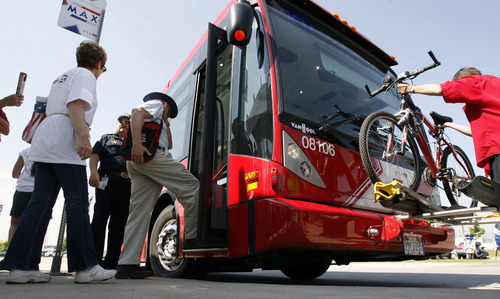This is an archived article that was published on sltrib.com in 2011, and information in the article may be outdated. It is provided only for personal research purposes and may not be reprinted.
Ninety percent of Salt Lake County bus routes will change — and 10 percent will be eliminated — under a final system redesign unveiled Thursday by the Utah Transit Authority.
UTA is cutting, shortening or combining bus routes countywide to pay to operate the new Mid-Jordan and West Valley City TRAX lines that are scheduled to begin operation on Aug. 7, the day that the bus system changes will also take effect.
UTA spokesman Gerry Carpenter said the recession deeply cut sales taxes that fund about 80 percent of UTA operations, which forced the cuts. He said UTA's budget this year is $70 million lower than what the agency had projected when the two new TRAX lines were planned.
Even with the bus cuts, Carpenter said UTA estimates that overall ridership will increase a minimum of 6 percent between adding the two new TRAX lines and implementing changes that preserve the most popular bus routes by discarding or combining little-used ones.
"We will have more miles of service than ever before when you combine bus and rail. We will have more riders than ever before, and we will meet our budget," said Lorin Simpson, UTA regional general manager for buses in Salt Lake County.
Maps and descriptions of route-by-route changes are available online at rideuta.com. However, detailed hourly schedules will not be available until July 7, Carpenter said.
Simpson said impacts to the bus system could have been more severe, but comments from riders suggested some creative changes and route combinations that preserved transit in most areas on most days.
For example, UTA had considered eliminating all Sunday buses to save money, but it ended up saving most. Simpson said many riders suggested that some Sunday routes were used more than some weekday routes. UTA looked at that, found it was true, and dumped the less popular routes instead. Also, UTA said it was persuaded that the Sunday routes were essential to many riders for jobs.
"How you decide where to cut when you have a limited budget is based on low ridership, inefficient services and services where you have supporting or back-up options for people," Simpson said.
In another case, about 100 riders who used the Route 320 fast bus from Sandy to downtown Salt Lake City were upset their route had been proposed for elimination. They proposed instead that just a couple of buses each in the morning and evening be offered, which would fill buses and save money. UTA found that made economic sense and adopted that.
David Sturgeon, a Route 320 rider who helped lead a protest over its proposed demise, said, "I'm excited they chose to maintain the route but am disappointed they couldn't see that on their own — and that we had to protest and create a little nuisance."
In other moves, UTA shortened many routes that used to run from sites in the western valley to downtown Salt Lake City to instead take riders to the new TRAX routes where they can transfer.
Simpson said the agency heard hundreds of comments from residents in Herriman, Riverton and South Jordan concerned about the loss of express buses from there to downtown Salt Lake City.
He said UTA came up with a new shuttle in some of those areas that gives frequent service to the new Mid-Jordan TRAX line. Also, research showed that many riders drove cars to park-and-ride lots to take fast buses, and found driving instead to TRAX parking lots will result in a commute that is essentially the same, since TRAX moves faster than buses.
Simpson said rider comments also showed that earlier proposals would have left a void of bus service in Salt Lake City's industrial northwest quadrant, because routes that ran there were shortened to go directly to TRAX lines. He said UTA found savings to allow shuttles to circulate through that area.
Simpson said that about 60 percent of all concerns raised by riders during UTA's earlier comment period were largely solved.
"The public gave us terrific ideas," he said.
Carpenter added, "Our planners have done some terrific things and stretched the budget beyond what any of us had hoped."
Carpenter said some people who find that transit will no longer work for them because of the changes could consider van pool service offered by the agency — where vans are offered for low cost — or consider using UTA's service that helps match people with similar schedules into carpools. —
Online
See a full list of the route changes here: http://bit.ly/lYWqKM



